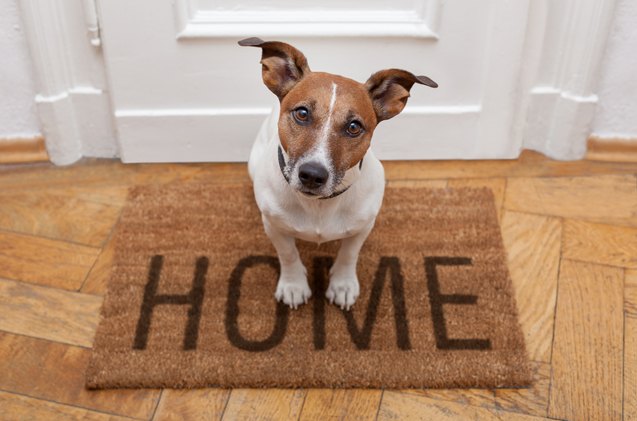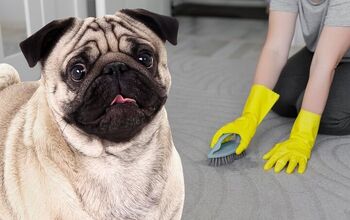Bringing A Dog Home From the Shelter – What To Expect The First Day

Congratulations! You’ve just adopted a dog from the shelter. But the excitement doesn’t stop there – the first day home is an emotional one for the humans and a stressful one for the shelter dog. Even if the change is a great one, it’s still a big change, and it can have an impact on your new pet’s behavior. The air of excitement and the new period of adjustment can even catch you unprepared and lead you to make some beginner’s mistakes when it comes to welcoming a new dog into the household. However, there are a few things you can do when bringing a dog home from the shelter that will make the first few days in your dog’s new home happy and calming, as well as help to establish your place as pack leader.
We know that the first thing you want to do when bringing a dog home from the shelter is to shower your new pooch with hugs and kisses. But hold off. Yes, a hug to humans conveys love and acceptance, but to a dog, it signals dominance and invasion of space. Give him some space until he has gotten to know you a bit better… then let the loving commence! This usually takes a couple of days, but as soon as your dog is comfortable in a new situation, they’ll be up for cuddles. Don’t force your new shelter dog into uncomfortable situations and take things slowly – you have many happy years ahead for the both of you.
However, just because you don’t want to signal overwhelming dominance to your new pet, it doesn’t mean that you shouldn’t establish yourself as the leader of the pack right away. Being firm and confident will not only help you train your dog later on, but it will actually help your dog feel more comfortable around you.
On the day that you’re bringing a dog home from the shelter, we’re going to ask you to do something you might not expect – don’t bring him inside (just yet). This is an eventful day and it’s likely that your shelter dog will be full of energy. After you park the car, take your new dog for a walk to burn off some of that excess energy.
In addition to helping him burn off that excitement-generated energy, a walk will also give your dog to unwind and relax a bit before being introduced to his new home. As well, you’ll be establishing yourself as the pack leader – just be sure the dog stays beside or behind you on the walk. A walk around the neighborhood is a great way to introduce your pup to his new surroundings, and it gives him a chance to give the area a good sniffing.
Now it’s time to go inside. But don’t just let your new shelter dog off the leash to investigate his new home. You’re the pack leader, remember? It’s your job to set down the rules right from the start. You go through doors and entranceways first, followed by the dog. Lead the dog around your home on a leash, going from room to room (you always taking the lead and going in first). Spend about 10 minutes in each room, letting him sniff around.
Be sure that other family members don’t come rushing at the dog with kisses and hugs (we established why earlier in the article). Other family members should greet the dog calmly, not talking to him and letting him sniff them. Gradual introductions are best in any case, especially with shelter dogs, You might not know their past, but it’s likely to have been a ruff one if they ended up surrendered to a shelter. This is why it’s best to keep their stress of meeting new people to a minimum and give them time to adjust to all the changes before expecting them to become a social butterfly.
Your dog’s bed or crate should be set up before bringing a dog home. Save his area for the last stop on the tour. Give him a chance to sniff it and leave a few bones or treats out for him – that way, the dog will always see this as a positive place. If your dog is calm at this time, you can start petting and showing him affection. Rub his head, belly or back, but resist giving him a hug just yet. It’s very important that your dog is calm for this part. If he is still hyper, take him for another walk to help tire him out.
A cozy corner of your home where your rescue dog can retreat for some alone time is absolutely crucial. If things get too overwhelming and he feels like he needs a timeout, a comfy bed in the corner of the room or a reassuring nest that can be a furnished crate are just what he needs to relax. Once you’ve commenced the tour of the house and he’s been introduced to the other family members, feel free to give your shelter dog some food and water. Also, be sure to take frequent bathroom breaks until you’ve established a routine.
Your first day of excitement is not over yet- it’s time for your dog to sleep in their new home for the first time. It can be hard for a dog to relax and go to sleep somewhere where they are not accustomed to, but the fact they’ll be knackered from all the excitement works in your favor. However, sleeping arrangements will still require a bit of an effort from your side. Most people opt for setting up a crate for their rescue’s first night in their home, even if they are not planning on crating their dog in the future.
Not only that a crate will ensure that your new family member doesn’t go out and make a mess of things while he’s still adjusting, but it will also give him a sense of safety and security to have a secluded nook to curl up in. You can even place the crate in your bedroom if you want him to know you’re nearby and there’s nothing to be afraid of.
In all likelihood, you’ll be getting your new furry best friend used to food and treats he may not be used to. If you want to continue to feed him the food he was eating with his breeder or the shelter/rescue, what-have-you, that’s fine. But it’s likely you’ll want to switch it up and you’ll want to be careful about how you do.
According to the AKC, if you switch your dog’s food too quickly, you may see him suffer from signs of gastrointestinal distress. This could look like vomiting, diarrhea or even a lack of desire to eat. It could also look like him wanting to wolf everything he can down because he’s simply not absorbing enough nutrients from what he is eating. The AKC recommends the following schedule (if at all possible and you have access to the current/old food) for switching a dog’s food when you first get them:
- Day 1: 25% new diet and 75% old diet.
- Day 3: 50% new diet and 50% old diet.
- Day 5: 75% new diet and 25% old diet.
- Day 7: 100% new diet.
This will also be the time you learn about your dog’s sensitivities, as if this timeframe doesn’t seem to do the trick, you may need to give him a bit longer of an adjustment as you mix the foods. You will never go wrong supplementing with a great probiotic/fiber/digestive enzyme supplement to keep gastrointestinal distress down and increase his overall gut health quality. Mostly, you’ll want to watch how he does, and make sure that he adjusts to the new change well. If it seems he adjusts too well, and eats like he’s never eaten before, you may want to look at feeders that will slow that gulping down. Dogs who eat too quickly can deal with issues like regurgitation too. If you’ve rescued your dog from the shelter, odds are they’re not used to not worrying about food, so they may have a propensity to wolf it down.
At the end of the day, bringing a new dog into your home and life is something different for the both of you. But it’s something different that’s PAWESOME and you can totally do it. Just follow these tips and remember that every transition is just that–a transition. It’s not permanent and once he (and you) settles into routine? It’ll be like he’d always been there!

Amy Tokic, Editor of PetGuide.com, is a passionate animal lover and proud pet parent of Oscar, a Shih Tzu/Chihuahua cross, and Zed, a Japanese Chin. Her love of animals began in kindergarten, when she brought her stuffed dog Snoopy into class with her every day. Now, she writes about her adventures in pet ownership and tirelessly researches products, news and health related issues she can share with other animal enthusiasts. In her free time, Amy loves perusing used book and record stores, obsessing over the latest pet products available and chasing squirrels with wild abandon (a habit attributed to spending too much time with her pooches).
More by Amy Tokic























